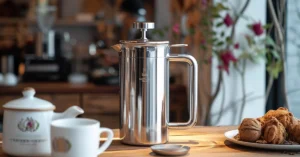If you’re a coffee lover, you might be wondering how to make coffee with whole beans. Actually, there are several different ways you can make coffee with whole beans. Additionally, using whole beans instead of pre-ground coffee can result in a richer and more flavorful cup of coffee.
In this article, we have covered two topics:
- First: How to make coffee with whole beans after you ground the coffee beans
- Secondly: How to make coffee with coffee beans without grinding them
One of the main advantages of using whole beans is that they retain their freshness for longer. Once coffee beans are ground, they begin to lose their flavor and aroma due to exposure to air. By using whole beans and grinding them just before brewing, you can ensure that your coffee is as fresh as possible. Additionally, whole beans allow you to have more control over the grind’s texture, which can affect the taste of your coffee.
There are a few different methods you can use, such as steeping the beans in hot water or using a double boiler to keep the heat consistent while the beans steep. Each method has its own benefits and drawbacks, so it’s worth experimenting to find the one that works best for you. Let’s get into the topic of how to make coffee with whole beans.
Understanding Coffee Beans
What are whole coffee beans?
Whole coffee beans are simply coffee beans that have not been ground yet. They are the raw form of coffee that is harvested from coffee plants. Coffee beans come in various shapes, sizes, and colors, depending on the type of coffee plant and where it is grown. Some of the most common types of coffee beans include Arabica, Robusta, and Liberica.
Importance of freshly ground coffee
Freshly ground coffee is crucial to getting the best flavor out of your coffee beans. When coffee beans are ground, they release oils and aromas that give coffee its unique flavor and aroma. These oils and aromas are volatile, meaning they evaporate quickly when exposed to air. Therefore, the longer coffee grounds sit around, the more they lose their flavor and aroma.
4 oz Pack of 5 Assorted Single-Origin Gourmet Coffee Gifts
Whole Beans vs. Pre-Ground Coffee
Whole bean coffee has a longer shelf life than pre-ground coffee because the beans are still intact and have not been exposed to air. Pre-ground coffee, on the other hand, loses its flavor and aroma quickly because the coffee grounds have been exposed to air. This is why it is always recommended to grind your coffee beans just before brewing.
Additionally, whole bean coffee allows you to control the grind size, which can affect the flavor of your coffee. For example, a finer grind is better for espresso, while a coarser grind is better for French press.
The basics of making coffee with whole beans
Making coffee with whole beans is a great way to enjoy a fresh, flavorful cup of coffee. Here are some basics to get you started:
Choosing the right beans
When choosing whole beans for your coffee, consider the roast level and origin. Roast level determines the flavor profile of the coffee, with darker roasts having a more intense, smoky flavor and lighter roasts having a more delicate, fruity flavor. Origin can also affect flavor, with beans from different regions having unique flavor profiles.
Understanding roast levels and origin

Here’s a quick breakdown of roast levels:
- Light roast: Light brown color, mild flavor, no oil on the surface of the beans.
- Medium roast: Medium brown color, balanced flavor, some oil on the surface of the beans.
- Dark roast: Dark brown color, intense flavor, shiny oil on the surface of the beans.
As for origin, here are some general flavor profiles:
- Central American beans: Bright, fruity, and acidic.
- South American beans: Nutty, chocolatey, and smooth.
- African beans: Floral, fruity, and bold.
- Asian beans: Earthy, spicy, and full-bodied.
Bean storage tips
To keep your whole beans fresh, store them in an airtight container in a cool, dry place. Avoid storing them in the fridge or freezer, as moisture can affect the flavor. It’s also a good idea to only grind the amount of beans you need for each cup of coffee, as ground coffee loses flavor more quickly than whole beans.
By following these basics, you’ll be on your way to making a delicious cup of coffee with whole beans.
Grinding Coffee Beans at Home: Essential Tools and Equipment

Grinding your coffee beans at home is an essential step in making a great cup of coffee. Coffee beans retain their flavor and aroma much longer than pre-ground coffee, so grinding your beans right before brewing ensures a fresher, more flavorful cup every time. To achieve this, you need a coffee grinder.
Choosing a coffee grinder
When it comes to choosing a coffee grinder, there are two main types: blade grinders and burr grinders. Blade grinders use a spinning blade to chop up the coffee beans, while burr grinders use two revolving abrasive surfaces to grind the beans more evenly.
Blade vs. burr grinders
Blade grinders are generally less expensive than burr grinders, but they tend to produce a less consistent grind and can overheat the beans, affecting the flavor. Burr grinders, on the other hand, produce a more consistent grind and allow for more control over the grind size.
Grinding techniques
When grinding your coffee beans, it’s important to use the right technique. For blade grinders, pulse the grinder in short bursts to prevent overheating and ensure a more even grind. For burr grinders, adjust the grind size based on your brewing method and make sure to clean the grinder regularly to prevent buildup.
Other brewing tools
In addition to a coffee grinder, there are a variety of other brewing tools you may need, depending on your preferred brewing method. This may include a coffee maker, French press, pour-over setup, or espresso machine. Each method requires a different grind size, so make sure to adjust your grinder accordingly.
Grind size and its impact on extraction
The grind size of your coffee beans plays a crucial role in the extraction process. A finer grind size will extract more quickly, resulting in a stronger, more intense flavor, while a coarser grind size will extract more slowly, resulting in a milder, less intense flavor. It’s important to experiment with different grind sizes to find the perfect balance for your taste.
Adjusting grind size for different brewing methods
Different brewing methods require different grind sizes. For example, French press coffee requires a coarse grind, while espresso requires a very fine grind. Make sure to adjust your grinder accordingly to achieve the best possible flavor for your preferred brewing method.
Brewing Coffee with Whole Beans
If you’re wondering whether you can brew coffee with whole beans, the answer is yes. Whole beans take longer to brew than ground coffee, but they produce coffee with less bitterness and acidity. Here are a few things to keep in mind when brewing coffee with whole beans.
Popular brewing methods
There are several popular brewing methods that work well with whole beans. Here are a few examples:
- French Press: A French press is a simple and effective way to brew coffee with whole beans. Simply add your desired amount of beans to the press, pour in hot water, and let it steep for a few minutes before plunging the filter down to separate the beans from the coffee.
- Pour Over: A pour over coffee maker is another great option for brewing coffee with whole beans. Simply place the beans in a filter, pour hot water over them, and let it drip into your mug.
- Cold Brew: Cold brew coffee is made by steeping coffee grounds in water for an extended period of time. You can use whole beans for this method by grinding them coarsely and steeping them in cold water for 12-24 hours.
Brewing time and temperature
When brewing coffee with whole beans, it’s important to pay attention to the brewing time and temperature. The ideal temperature for brewing coffee is between 195-205°F (90-96°C). If the water is too hot, it can over-extract the coffee and produce a bitter taste. If the water is too cold, it can under-extract the coffee and produce a weak taste.
The brewing time can vary depending on the brewing method you choose, but a general rule of thumb is to brew for 4-5 minutes. However, if you’re using a cold brew method, you’ll need to steep the coffee for a longer period of time.
Troubleshooting Common Issues
Coffee brewing is an art as much as it is a science. Even the most experienced coffee brewers can run into issues from time to time. Here are some common issues you may encounter when making coffee with whole beans and how to fix them.
Overcoming bitter taste
If your coffee tastes bitter, it may be over-extracted. This means the coffee was brewed for too long or the grind was too fine. To fix this issue, try brewing for a shorter amount of time or use a coarser grind. Another possible cause of bitterness is using water that is too hot. Make sure to use water that is between 195-205°F (90-96°C) for optimal extraction.
Fixing weak coffee
If your coffee tastes weak, it may be under-extracted. This means the coffee was brewed for too short a time or the grind was too coarse. To fix this issue, try brewing for a longer amount of time or using a finer grind. Another possible cause of weak coffee is using too little coffee grounds. Aim for a ratio of 1:15 (coffee to water) for optimal extraction.
Grind consistency
Grind consistency is crucial for optimal coffee extraction. If your coffee tastes uneven or has a mixture of strong and weak flavors, it may be due to inconsistent grind size. To fix this issue, invest in a quality burr grinder and ensure it is properly calibrated. Alternatively, consider purchasing pre-ground coffee to ensure consistency.
Over-extraction and under-extraction: How to identify and adjust
Over-extraction and under-extraction can result in bitter or weak coffee, respectively. To identify over-extraction, look for a burnt or bitter taste. To identify under-extraction, look for a weak or sour taste. Adjust your brewing time, grind size, or coffee-to-water ratio accordingly to fix these issues.
Remember, making coffee with whole beans takes practice and patience. Don’t be discouraged if your first few attempts aren’t perfect. Keep experimenting and adjusting until you find the perfect brewing method for your taste buds.
FAQ – How to Make Coffee With Whole Beans
Is coffee better with whole beans?
Yes, coffee is better with whole beans. Whole beans retain their natural oils and flavors, which are lost when the beans are ground. This means that coffee brewed with whole beans has a richer, more complex flavor than coffee brewed with pre-ground beans.
Can I boil whole coffee beans?
Boiling whole coffee beans is not recommended, as it can result in a bitter and unpleasant taste. Boiling also causes the beans to release their oils, which can clog your coffee maker and ruin the flavor of your coffee.
How to make coffee with whole beans without a coffee maker?
Making coffee with whole beans without a coffee maker is possible. One way to do this is by using a French press or a pour-over coffee maker. Simply grind the beans to a coarse consistency, add hot water, and let the coffee steep for a few minutes before pressing or pouring.
Can you make coffee from beans without a grinder?
Yes, you can make coffee from beans without a grinder. One way to do this is by using a mortar and pestle or a rolling pin to crush the beans into a coarse consistency. You can then brew the coffee using a French press or a pour-over coffee maker.
What happens if I boil whole coffee beans?
Boiling whole coffee beans can cause the beans to release their oils, which can clog your coffee maker and ruin the flavor of your coffee. Boiling can also result in a bitter and unpleasant taste. It is best to avoid boiling whole coffee beans and instead use a coffee maker or a French press to brew your coffee.
If you liked this blog post about the topic: Make Coffee with whole Beans, don’t forget to leave us a comment down below to tell us about your experience with it.





